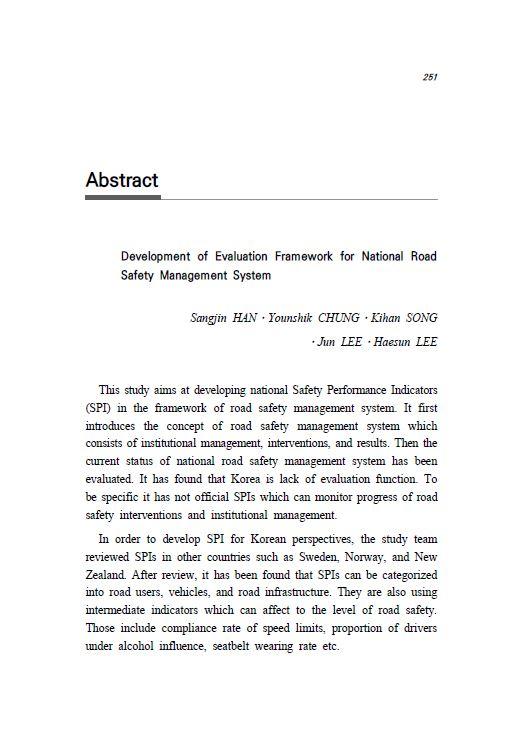Basic Report

RESEARCH
KOTI - Korea Transport institute
Development of Evaluation Framework for National Road Safety Management System
- Date
December 31 2015
- Page(s)
page(s)
#Safety System
#Safe System
#Road Safety Management System
#Domestic Road Traffic Safety System
#Swed

This study aims at developing national Safety Performance Indicators (SPI) in the framework of road safety management system. It first introduces the concept of road safety management system which consists of institutional management, interventions, and results. Then the current status of national road safety management system has been evaluated. It has found that Korea is lack of evaluation function. To be specific it has not official SPIs which can monitor progress of road safety interventions and institutional management. In order to develop SPI for Korean perspectives, the study team reviewed SPIs in other countries such as Sweden, Norway, and New Zealand. After review, it has been found that SPIs can be categorized into road users, vehicles, and road infrastructure. They are also using intermediate indicators which can affect to the level of road safety. Those include compliance rate of speed limits, proportion of drivers under alcohol influence, seatbelt wearing rate etc. The study also benchmarked Safety Management System in other transport sectors including railway and aviation. It has been found that they have stricter safety management system than that of road sector since operation companies should be responsible to the accident. In these modes even human errors are attributed to the wrong safety management of operators. They are not blaming drivers entirely even in the case of accidents occur from human errors. Furthermore they are applying risk assessment techniques which identify possible hazards and assess the level of risk of identified hazards. The study has developed various SPIs in three areas: 13 indicators for policy effort, 16 indicators for intermediate outcome, and 20 indicators for final outcome. All indicators are also grouped for road users, vehicles, and road environment. Policy effort indicators evaluate how much relevant government agencies tried to implement selected road safety interventions. Intermediate indicators evaluate how much government efforts improve safety of road users, vehicles and road infrastructure. The final outcome has been developed to monitor road safety status in various perspectives. Then Analytic Hierarch Process has been applied to calculate comparative weights of various indicators particularly for policy effort and intermediate outcome. The weights then help us scoring overall performance for policy efforts and intermediate outcome. This score can also help us understanding how policy efforts or intermediate outcome change for each year and how they are interrelated to the final outcome. This scoring system can also be applied to monitor accountability of government agencies for road safety because SPIs can be grouped for relevant agencies.
However, the suggested SPIs need to be further adjusted to reflect difficulties or interests of relevant government agencies before implementation. Some suggested SPIs cannot be accepted owing to difficulties of reliable data collection. Others may be questioned on the relevance to the role of agencies to be evaluated. The implementation in itself also needs to be supported by the law in order to avoid unnecessary arguments over its usefulness. Furthermore, there should be a management system for SPIs. This includes SPI development, evaluation, and publication of results. It is indispensable to maintain sustainability of SPI evaluation. The developed SPIs can be further adapted to be applied in local governments. This should be helpful to understand what efforts need to be taken to improve road safety in local governments. Finally international comparison of SPIs can contribute on benchmarking road safety policies in various countries.
However, the suggested SPIs need to be further adjusted to reflect difficulties or interests of relevant government agencies before implementation. Some suggested SPIs cannot be accepted owing to difficulties of reliable data collection. Others may be questioned on the relevance to the role of agencies to be evaluated. The implementation in itself also needs to be supported by the law in order to avoid unnecessary arguments over its usefulness. Furthermore, there should be a management system for SPIs. This includes SPI development, evaluation, and publication of results. It is indispensable to maintain sustainability of SPI evaluation. The developed SPIs can be further adapted to be applied in local governments. This should be helpful to understand what efforts need to be taken to improve road safety in local governments. Finally international comparison of SPIs can contribute on benchmarking road safety policies in various countries.